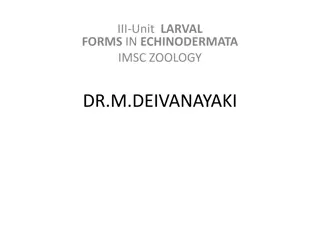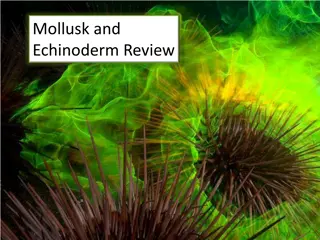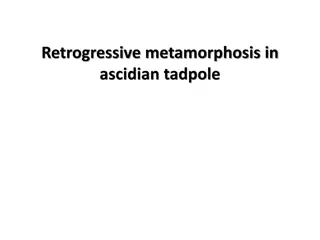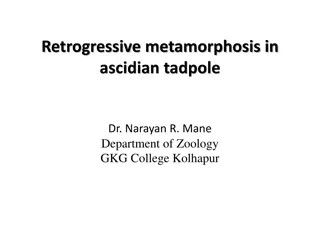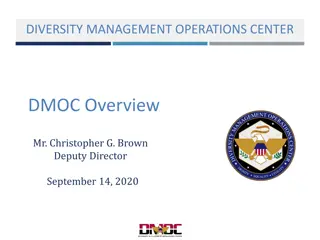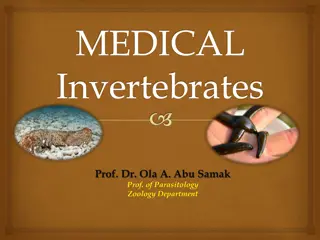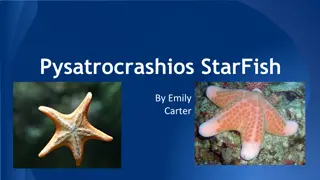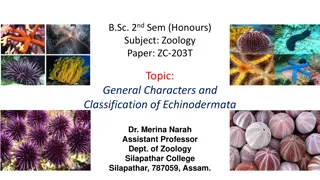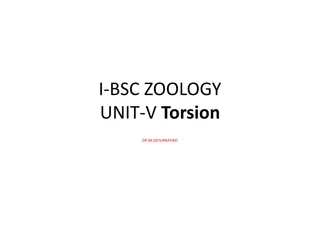Larval Forms in Echinoderms: Development and Diversity
Echinoderms exhibit various larval forms as part of their life cycle, with different classes showcasing distinct types of larvae. These larvae undergo metamorphosis to transition into the characteristic radial symmetrical adults. The bipinnaria, brachiolaria, auricularia, and ophiopluteus larvae are examples of these developmental stages in echinoderms. Each larval form has unique characteristics and plays a crucial role in the overall life history of these fascinating marine organisms.
Download Presentation

Please find below an Image/Link to download the presentation.
The content on the website is provided AS IS for your information and personal use only. It may not be sold, licensed, or shared on other websites without obtaining consent from the author. Download presentation by click this link. If you encounter any issues during the download, it is possible that the publisher has removed the file from their server.
E N D
Presentation Transcript
DR.M.DEIVANAYAKI I BSC ZOOLOGY
LARVAL FORMS IN ECHINODERMATA. ... Echinoderms are deuterostomes and hence cleavage is radial, holoblastic and indeterminate. The larvae hatch in water and feed and grow through successive larval stages to become adults. The larvae of echinoderms are bilaterally symmetrical but lose symmetry during metamorphosis. Echinoderms are unisexual animals. Sexual dimorphism is absent. Fertilisation takes place in water. The development may be direct or indirect. If the development is indirect it includes larva stages. In different classes of echinoderms, different types of larvae complete the development. The larval form is bilaterally symmetrical. It undergoes metamorphosis and radial symmetrical adult is developed Class of Phylum Echinodermata Larval form 1. Asteriodea 2. Ophiuroidea 3. Echinoidea 4. Hobturoidea 5. Crinoidea Bipinnaria & Brachiolaria Ophiopkiteus Echinopkrteus Auricularia Dobolaria & Pentacrinoid
1.Bipinnaria Larva: It is the larva form seen in the life history of Star fish. The fertilised egg is homolecithal. ft undergoes hobblastic cleavage and devebps into blastula and gastrula stages. The gastrula elongates in length and it gives rise to Bipinnaria larva. It is a bilaterally symmetrical free swimming pelagic larva. The pre-oral region is elongated. Post-oral region is broad. The anterior end forms pre-oral lobe. The ciliated band at the pre-iral lobe 'orms into 2 separate bands, Pre-oral band of cilia, and post oral band of cilia. These 2 bands of cilia are drawn into many arms. They are nothing to do with the arms of the star fish. They are, Ventro-median arm. A pair of pre-oral arm. Median dorsal arm. A pair of antero-dorsai arm. A pair of posterio-dorsal arm. A pair of posterio-lateral arm. A pair of post oral arm. The digestive system is developed with mouth and anus. This larva resembles Tomaria larva of Balanoglossus. This larva slowly grow s into the next larval form called Brachiolaria larva.
2.Brachiolaria Larva : Bipinnaria larva swims for few weeks in the sea water.lt finally transforms into next larval stage called Brachiolaria larva. It is bilaterally symmetrical larva. It is pelagic larval form, it shows 3 brachiolar arms with suckers. They are one median and two lateral in position. At the tip of brachiolar arms adhesive structures will make their appearance and they are for attachment. The larva shows all the arms that areseen in the Bipinnaria, but these arms are very long and hanging. These ciliated arms will be helpful for swimming in the water. The digestive system is completely developed with definite stomach and intestine. This larva after swimming few settle-on a solid object and gets attached to it by its adhesive arms. Posterior end of the larva enlarges and lifts to the right-side. From this rudiments of 5 arms will arise. Thus slowly the larva metamorphosis into an adult. 3.Auricularia Larva: In Holothuroidea this larval form is seen. It is a free swimming pelagic larva. Arms are absent. Alimentary canal is developed. It opens with mouth and ends with anus. Intestine is curved. In Japan and Bermuda very big auricularia larval forms are developed. They are 15 mm in length. Usually this larva is 1 mm in length. Ciliated bands are well-developed. Ciliated band continues through oral loop and anal loop.
4.Ophiopluteus Larva: This larva is seen in the life history of opuriodea (Brittle star). It shows many long arms. It is bilaterally symmetrical. It is transparent. It is Pelagic. The arms are supported by calcareous rods. The arms are directed upwards. Preoral loop is reduced . Ciliated band is undivided. The posterc-lateral arms are very long and they are directed forwards. The digestive system is developed. It opens with mouth and ends with anus. This larva swims for some timebefore undergoing metamorphosis. 5. Echinopluteus Larva: It is seen in the life history of Echinoidea. It is a microscopic larva. It swims in water. This larva shows ciliated bands which are developed into arms. Fully developed echinopluteus larva 4 or 5 pairs of arms are present. Usually 6 pairs of arms should be resulted. The arms are supported by (CaCO3) Calcareous rods. The digestive system is developed which shows mouth and anus. It develops hydrocoel and vestibule. These parts grow on the oral side of the animal. From the hydrocoel five radial canals will develop. This larva undergoes rapid metamorphosis and develops into an adult.
6.Doliolaria Larva: In crinoidea group of animals the larval form is Doliolaria larva. It is a free swimming larval form. It contains an apical tuft of cilia which will be sensory. On the mid ventral line near apical plate adhesive pit will be present. The body shows 4 or 5 ciliated bands In between 3rd and 2nd ciliated bands vestibule is present. After swimming for some time it will develop a stalk. It is called Pantacrinoid larva. It will attach to the substartum. The internal organs will rotate at 90 . It develops into an adult. Significance of Echinoderm larva : The larval forms of all classes in Echinodermata will show general resemblance. The crinoidea larva differs from this pattern. In general all the larvae show that they might have come from same ancestor. Hence the common ancestor is coelomate, bilaterally symmetrical and free swimming. These larvae also show resemblance with Toronaria of Balanoglossus. Thus the study of Echinoderm larva has a phylogenetic significance.
Significance of Echinoderm larva : The larval forms of all classes in Echinodermata will show general resemblance. ... In general all the larvae show that they might have come from same ancestor. Hence the common ancestor is coelomate, bilaterally symmetrical and free swimming. All the larval of echinoderms have a bilateral symmetry. Hence it is believed that the ancestor of echinoderms was a bilaterally symmetrical animal. According to Bather(1900), this ancestor was called dipleurula. But according to Semon(1988) this ancestor was called Pentaetulla. The pentaetulla ancestor was universally accepted. The radial symmetry of exhibited by Coelenterate and Porifera is primary. The radial symmetry in Echinoderm is superficial, concealing the true bilateral symmetry. The adult Echinoderms are more primitive than larvae because they possess the features of lower animals like Porifera and Coelenterala. The primitive characters are radial symmetry, absence of head, lack of anterior and posterior ends. Hence during Metamorphosis the advanced larva becomes a primitive adult. Hence the Metamorphosis is Retrogressive.


